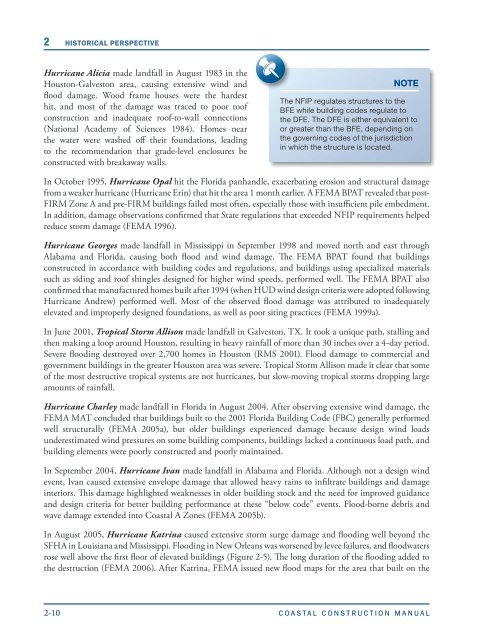Coastal Construction Manual - National Ready Mixed Concrete ...
Coastal Construction Manual - National Ready Mixed Concrete ...
Coastal Construction Manual - National Ready Mixed Concrete ...
You also want an ePaper? Increase the reach of your titles
YUMPU automatically turns print PDFs into web optimized ePapers that Google loves.
2 HISTORICAL PERSPECTIVE<br />
Hurricane Alicia made landfall in August 1983 in the<br />
Houston-Galveston area, causing extensive wind and<br />
flood damage. Wood frame houses were the hardest<br />
hit, and most of the damage was traced to poor roof<br />
construction and inadequate roof-to-wall connections<br />
(<strong>National</strong> Academy of Sciences 1984). Homes near<br />
the water were washed off their foundations, leading<br />
to the recommendation that grade-level enclosures be<br />
constructed with breakaway walls.<br />
NOTE<br />
The NFIP regulates structures to the<br />
BFE while building codes regulate to<br />
the DFE. The DFE is either equivalent to<br />
or greater than the BFE, depending on<br />
the governing codes of the jurisdiction<br />
in which the structure is located.<br />
In October 1995, Hurricane Opal hit the Florida panhandle, exacerbating erosion and structural damage<br />
from a weaker hurricane (Hurricane Erin) that hit the area 1 month earlier. A FEMA BPAT revealed that post-<br />
FIRM Zone A and pre-FIRM buildings failed most often, especially those with insufficient pile embedment.<br />
In addition, damage observations confirmed that State regulations that exceeded NFIP requirements helped<br />
reduce storm damage (FEMA 1996).<br />
Hurricane Georges made landfall in Mississippi in September 1998 and moved north and east through<br />
Alabama and Florida, causing both flood and wind damage. The FEMA BPAT found that buildings<br />
constructed in accordance with building codes and regulations, and buildings using specialized materials<br />
such as siding and roof shingles designed for higher wind speeds, performed well. The FEMA BPAT also<br />
confirmed that manufactured homes built after 1994 (when HUD wind design criteria were adopted following<br />
Hurricane Andrew) performed well. Most of the observed flood damage was attributed to inadequately<br />
elevated and improperly designed foundations, as well as poor siting practices (FEMA 1999a).<br />
In June 2001, Tropical Storm Allison made landfall in Galveston, TX. It took a unique path, stalling and<br />
then making a loop around Houston, resulting in heavy rainfall of more than 30 inches over a 4-day period.<br />
Severe flooding destroyed over 2,700 homes in Houston (RMS 2001). Flood damage to commercial and<br />
government buildings in the greater Houston area was severe. Tropical Storm Allison made it clear that some<br />
of the most destructive tropical systems are not hurricanes, but slow-moving tropical storms dropping large<br />
amounts of rainfall.<br />
Hurricane Charley made landfall in Florida in August 2004. After observing extensive wind damage, the<br />
FEMA MAT concluded that buildings built to the 2001 Florida Building Code (FBC) generally performed<br />
well structurally (FEMA 2005a), but older buildings experienced damage because design wind loads<br />
underestimated wind pressures on some building components, buildings lacked a continuous load path, and<br />
building elements were poorly constructed and poorly maintained.<br />
In September 2004, Hurricane Ivan made landfall in Alabama and Florida. Although not a design wind<br />
event, Ivan caused extensive envelope damage that allowed heavy rains to infiltrate buildings and damage<br />
interiors. This damage highlighted weaknesses in older building stock and the need for improved guidance<br />
and design criteria for better building performance at these “below code” events. Flood-borne debris and<br />
wave damage extended into <strong>Coastal</strong> A Zones (FEMA 2005b).<br />
In August 2005, Hurricane Katrina caused extensive storm surge damage and flooding well beyond the<br />
SFHA in Louisiana and Mississippi. Flooding in New Orleans was worsened by levee failures, and floodwaters<br />
rose well above the first floor of elevated buildings (Figure 2-5). The long duration of the flooding added to<br />
the destruction (FEMA 2006). After Katrina, FEMA issued new flood maps for the area that built on the<br />
2-10 COASTAL CONSTRUCTION MANUAL







